Gluck by Diana Souhami (most interesting books to read .TXT) 📗

- Author: Diana Souhami
Book online «Gluck by Diana Souhami (most interesting books to read .TXT) 📗». Author Diana Souhami
She had exacting standards of form and technique. Her musicality – she wavered between singing or painting as a career – is reflected in her strong visual sense of harmony and composition. She was literary which shows in her sense of implication of meaning – of more than meets the eye. And she was a perfectionist who took extraordinary care in matching colour and texture; she would spend days painting the underside of a petal of a flower with a brush with one or two hairs in it, until she got it right.
Her portraits of women are among her best work. The national art galleries house an abundance of reclining nudes but not many portraits of women by women. Gluck’s women wear their hats, jewellery and clothes, to show their self-assurance, assertiveness, status and style. Her portrait of Molly Mount Temple, at one of whose glittering party weekends at Broadlands Gluck met the love of her life, is a study in arrogance and disdain: arms akimbo, wearing clothes by Schiaparelli, her hat and aquamarines badges of status and power, her lips and nails bright red and an M for Molly and Mount Temple engraved on the buckle of her belt.
In the 1920s when the world was dancing mad, when every restaurant in town had a floorshow and C. B. Cochran’s reviews were a showcase for theatrical talent, Gluck went again and again to the London Pavilion, advertised as ‘The Centre of the World’, to paint scenes from the most popular of his shows, On with the Dance. In the thirties, much influenced by Constance Spry, she painted formal arrangements of flowers in ornate vases. Fashionable interior designers, Oliver Hill, Syrie Maugham, Norman Wilkinson, hung her paintings in rooms they designed. In the war years Gluck captured the spirit of the home front in pictures of soldiers playing snooker, or the firewarden’s office at one in the morning. In her last years, when she was beached, lost and lonely, that was what her painting showed: a lone bird flying into the sunset, waves washing in on a deserted shore, an iridescent fish head washed up by the tide.
Like Mondrian she tried to see paintings as part of an architectural setting. She designed and patented a frame which bears her name. It consisted of three symmetrically-stepped panels painted the same colour as the wall on which it was hung, or covered in the same paper. The effect was to incorporate the picture into the wall. She patented it in 1932 and used it in all subsequent exhibitions to create what became known as ‘The Gluck Room’, the total architectural effect of paintings and their setting.
Her private income meant she was not driven to earn her living from work. She painted only what she chose. She disliked commercialism, easy production and the second-rate in art: ‘I made a vow that I would never prostitute my work and I never have.… Never, never, have I attempted to earn my bread at the cost of my work.’5 She had, too, grand ideas of Time and Vision and her own genius. She was capable of spending three years on a picture then destroying it if she felt it to be no good:
Your thoughts span the heavens and the earth, why should your achievements be limited to the days. Think of each day as a part of Time and the ‘waste’ of this day will have no more meaning for you. You cannot waste time unless what you do is unworthy of your spirit. How surely will your tortoise run to someone else’s hare.6
She admitted to a sense of timelessness which in later life cost her dear:
As life went on I spent it prodigally, unwisely. The sense of timelessness deceived me into thinking my time was limitless for creation. Only within the last tormented years have I seen how ambivalent this sense of timelessness has been. It gave eternal qualities to my work, perhaps, but it also limited its output.7
When young she felt her life was charmed. Aged forty-one she fell in love and thought it would last for ever. In essence she was a romantic optimist and when Love ‘to all Eternity’ failed her, as in the 1940s Love did because it had no pragmatic base, she locked into sorrow with the tenacity she brought to work or pleasure. The failure of love crippled her self-regard, made her deny herself the consolation of work and behave in a destructive way toward those who sought to help her.
Obsession was her Aristotelian fatal flaw of character. At its best it supported her perfectionism – an absolute dedication and commitment to each of her paintings. At its most wasteful it caused her to ‘campaign’ on issues which she always regarded as important, but which consumed her time, energy and focus.
The great battle which kept her from her easel, was over the quality of artists’ materials. It became known as her ‘paint war’. She fought it with the paint manufacturers, the British Standards Institution and, it seemed, the world at large, for more than a decade – from 1953 to 1967. It began because she ran into difficulties when painting. Her materials started to behave unpredictably:
All industrially made oil paints throughout the world exhibit a greasy turbidity which I have named ‘the suede effect’ manifested by a change of tone and colour according to the direction taken by the brush. This disgusting effect is caused by pigments being too finely ground, linseed oil being hot pressed





Comments (0)